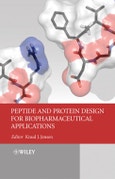Design of Peptides and Proteins provides an overview of the experimental and computational methods for peptide and protein design, with an emphasis on specific applications for therapeutics and biomedical research. Topics covered include:
- Computer modeling of peptides and proteins
- Peptidomimetics
- Design and synthesis of cyclic peptides
- Carbohydrates in peptide and protein design
- De novo design of peptides and proteins
- Medical development applications
- An extended case study - the design of insulin variants
Design of Peptides and Proteins presents the state-of-the-art of this exciting approach for therapeutics, with contributions from international experts. It is an essential resource for academic and industrial scientists in the fields of peptide and protein drug design, biomedicine, biochemistry, biophysics, molecular modelling, synthetic organic chemistry and medicinal/pharmaceutical chemistry.
Table of Contents
List of Contributors.Preface.
1. Introduction (Knud J. Jensen)..
2. Computational Approaches in Peptide and Protein Design: An Overview (Garland Marshall and Gregory Nikiforovich)..
2.1 Introduction.
2.2 Basics and Tools.
2.3 Computational Study of Cyclopentapeptide Inhibitors of CXCR4.
Acknowledgements.
References.
3. Aspects of Peptidomimetics (VeroniqueMaes and Dirk Tourwe)..
3.1 Introduction.
3.2 Modified Peptides.
3.3 Pseudopeptides.
3.4 Secondary Structure Mimics (Excluding Turn Mimics).
3.5 Examples of Peptidomimetics.
3.6 Conclusion.
References.
4. Design of Cyclic Peptides (Oliver Demmer, A. O. Frank, and Horst Kessler)..
4.1 Introduction.
4.2 Peptide Cyclization.
4.3 Conformation and Dynamics of Cyclic Peptides.
4.4 Concepts in Rational Design of Cyclic Peptides.
4.5 Examples of Cyclic Peptides as Drug Candidates.
4.6 Conclusion.
References.
5. Carbohydrates in Design of Peptides and Proteins (Knud J. Jensen and Jesper Brask)..
5.1 Introduction.
5.2 Configurational and conformational Properties of Carbohydrates.
5.3 Carbohydrates in Peptidomimetics.
5.4 Glycopeptides.
5.5 Carbohydrates as Scaffolds in the Design of Non-Peptide Peptidomimetics.
5.6 Sugar Amino Acids.
5.7 Cyclodextrin-Peptide Conjugate .
5.8 Carboproteins: Model Proteins on Carbohydrate Templates.
5.9 Conclusion Remarks.
6. De Novo design of proteins (Knud J. Jensen)..
6.1 Introduction.
6.2 Secondary Structure Elements.
6.3 Assembling a Specified Tertiary Structure from Secondary Structure Elements.
6.4 Proteins on Templates.
6.5 Foldamers.
6.6 Biopharmaceutical Applications of Protein De Novo Design.
References.
7. Design of Insulin Variants for Improved Treatment of Diabetes (Thomas Høeg-Jensen)..
7.1 Introduction.
7.2 Diabetes Management and the Need for Insulin Engineering.
7.3 Insulin Structure.
7.4 Prolonged-acting Insulin Solids.
7.5 Prolonged-acting Insulin Solutions.
7.6 Fast-acting Insulins.
7.7 Glucose-sensitive Insulin Preparations.
7.8 Alternative Insulin Delivery.
7.9 Insulin Mimetics.
7.10 Pushing the Limitations of Insulin Engineering.
7.11 Conclusion.
References.
Index..








